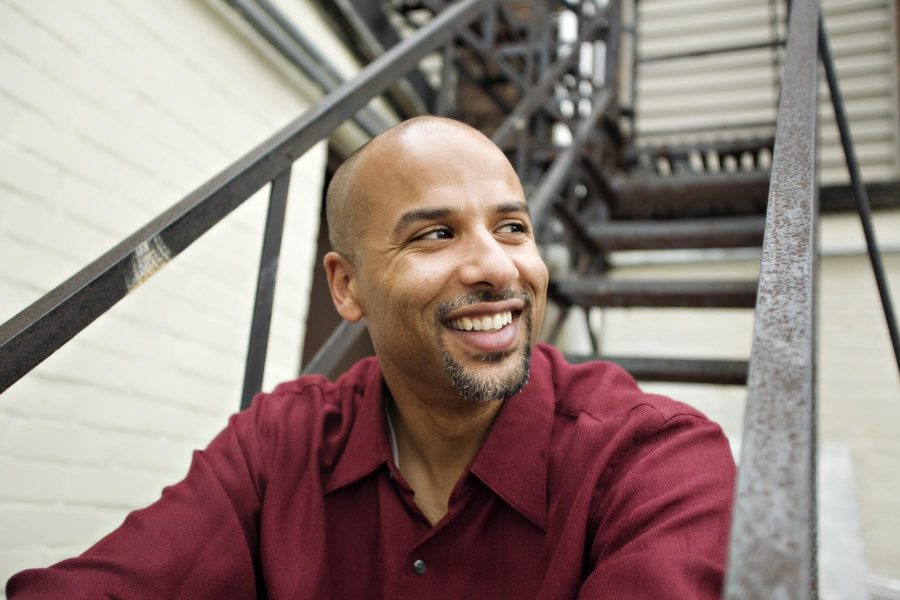On The Record with Professor Justin Emeka
Photo Courtesy of Justin Emeka
Associate Professor of Theater and Africana Studies Justin Emeka, OC ’95, directed a performance of excerpts from The Glass Menagerie in Cleveland Monday night.
February 24, 2017
Associate Professor of Theater and Africana Studies Justin Emeka, OC ’95, discovered acting at a young age, but racially restrictive casting drove him more toward directing. He graduated with a master’s degree in directing from the University of Washington School of Drama in 2005 and has been extensively involved in staging works of classical theater productions with Black casts for many years. Emeka hosted an event called “Re-imagining Classical American Theater” at the Playhouse Square in Cleveland Monday evening. The event incorporated a discussion on the concept of reimagining dramatic works to illuminate Black history and narratives and showcased two scenes from Tennessee Williams’ The Glass Menagerie, directed by Emeka and featuring Oscar-nominated actress Margaret Avery.
This interview has been edited for length and clarity.
When and why did you choose theater?
I was always a rambunctious child. My mother recognized that early and brought me to a theater class kind of on a whim. She thought I might like it because I seemed to like attention; I was very expressive, and I had no problem with people looking at me. I really liked it, and I asked her to take me to another one. I started taking any acting class that I could, [auditioning] for anything that I could audition for, … looking in the newspapers for auditions for commercials or movies … and [going] to cattle calls. By the time I was [a young man] I had a decent career, but as I got older I started to become frustrated with the roles that I was allowed to audition for because of my cultural and racial background, so then I started to become more interested in directing and controlling which stories get told.
This production was one of several events and performances in celebration of Black History Month. Can you tell me more about Oberlin’s history of celebrating Black history through performance?
Oberlin has a long legacy of using the arts, particularly theater, music, dance, as a way to celebrate the African and African-American experience in America. In February — and throughout the whole year — there has been a brilliant commitment [by] students, scholars and faculty to shine a light on the Black experience through the arts, … [like] Wendell Logan, [who helped] form the Jazz department, … from the ’70s to 2010 when the Jazz building was finally erected.
Why did you choose The Glass Menagerie?
I’m particularly drawn to the story of a young man who suffers from the guilt of having abandoned his mother and [sister] to go and pursue his dreams. The play looks at the cost for a young artist to pursue their own dreams, the cost in their own lives and the cost in the family’s lives, and that story is very rich within the context of any culture. The longing of a young man who … feels bound by the responsibility of providing for his family because … the father has abandoned them, that story really resonated with me in thinking about how I can use the Black experience to illuminate the complexities of that story.
Did you change Tennessee Williams’ script at all? Why or why not?
There are four or five different versions of Glass Menagerie, so I did look and pick from those different versions to put together our version. The small references that we did change were to help us locate the context of the family and the story within a Black reality. For instance, Amanda refers to being a part of the Daughters of the American Revolution. That was a high society for white women at the time that a Black woman wouldn’t have been a part of, so [we found] a reference that is similar, … a high society Black female group. We used a Black sorority, Delta Sigma Theta, in exchange.
How did the production come together?
Margaret Avery is an incredible film and television actor who came to me because she was very interested in working in theater, because as an actor she felt that was the best way to engage in the heart of her craft. She was interested in doing a classical piece. A mutual friend of ours connected us and we talked about a classical piece to work on, and I suggested Glass Menagerie. About four months ago, she and I and the cast got together and read it by ourselves … and we spent the weekend reading the play and just talking about it with ourselves in terms of how we felt about it, how the characters resonated in the context of our own lives, seeing if we could find our way into the play. This is kind of the next incarnation of this developmental work. Margaret came to town again, and we spent another weekend putting it on its feet. … We had another wonderful time wrestling with the text, getting to know each other as artists. Now we’re hoping to continue to develop the piece and ultimately do a full production of The Glass Menagerie.
What does it feel like to arrange and direct something like this?
I really enjoy the intense detail that this type of work requires when you’re … transplanting a story into another cultural context. It really allows me to take advantage of my background as a scholar and a historian as well as my background as an artist and as a director … [to shine] a light on different cultural references that normally are overlooked while using a classic text that people are not necessarily accustomed to seeing Black life exist in, in some sense shining a light on the Black experience in places we haven’t been taught to look for it. I think these classical texts lend themselves well to reimaginings, partially because if you look at any moment in history in any part of the planet, if you look close enough you’ll find Black life shining unapologetically. I like using these opportunities as a way to uncover these rich stories that have been buried or [that] a lot of people have been taught are not possible. When we talk about non-traditional casting, I’ve always thought it was kind of odd that people would rely on the audience to believe that a Black actor and a white actor could be blood relatives but couldn’t believe that Black culture actually existed in the world of the play. We have to train our imaginations to see Black reflections in every direction.
Can you talk about some of the other reimagined works of classical theater you’ve been involved in?
One of the first big reimaginings I was a part of was King Lear at the Yale Repertory Theater. Avery Brooks, [OC ’70], also an Oberlin alum and one of my mentors, invited me to participate, first as a movement coordinator and then to play the role of Edgar. He had set King Lear in pre-Columbus America, 3,000 years before Columbus arrived, imagining that King Lear was one of the African kings that rode the ocean currents that Dr. Ivan Van Sertima has identified that led to exchange between Africa and Native Americans. That concept blew me away and set me on a [path] that I’ve really spent the last 15 years [on], looking at texts such as Macbeth set in America after the Civil War, or Romeo and Juliet as a struggle between a Black American family and a West Indian family, [or] Death of a Salesman as a Black family in juxtaposition to a Jewish family next door, and seeing how their relationship is built by love, compassion and competition.
Is there anything I haven’t touched on that you’d like to talk about?
I’m really proud of the work I’ve been able to do with Oberlin students as well. Every production that I’ve directed since I came to Oberlin 10 years ago has had an Oberlin student involved in the cast wherever in the world I’ve directed. It’s really been powerful to be able to involve [my] students in the work and be inspired by the energy and this sense of wonder that they bring to the projects. Calypso Smith, who is a senior, and Caylen Bryant, who is a double-degree [senior], really brought some incredible layers to the piece. As a teacher, it’s so rewarding to be able to see them working in a professional context and see them apply stuff that they’ve picked up in my classes. To see them incorporate that into their professional lives is really rich.


























